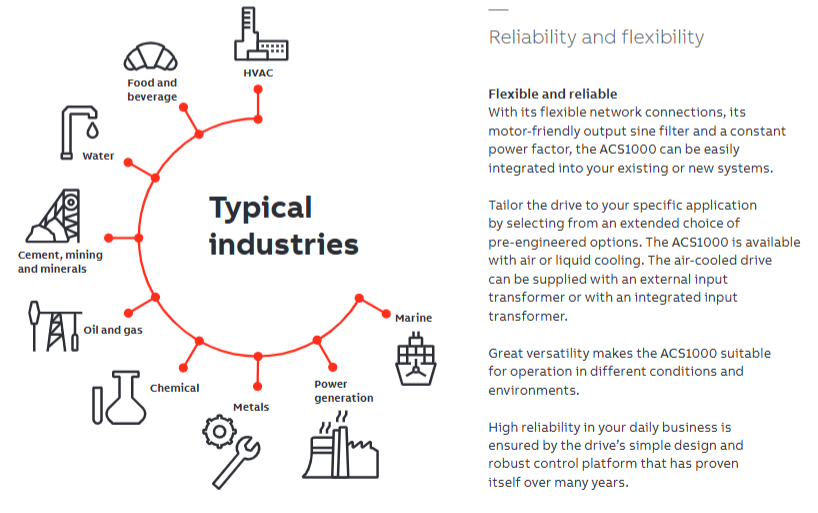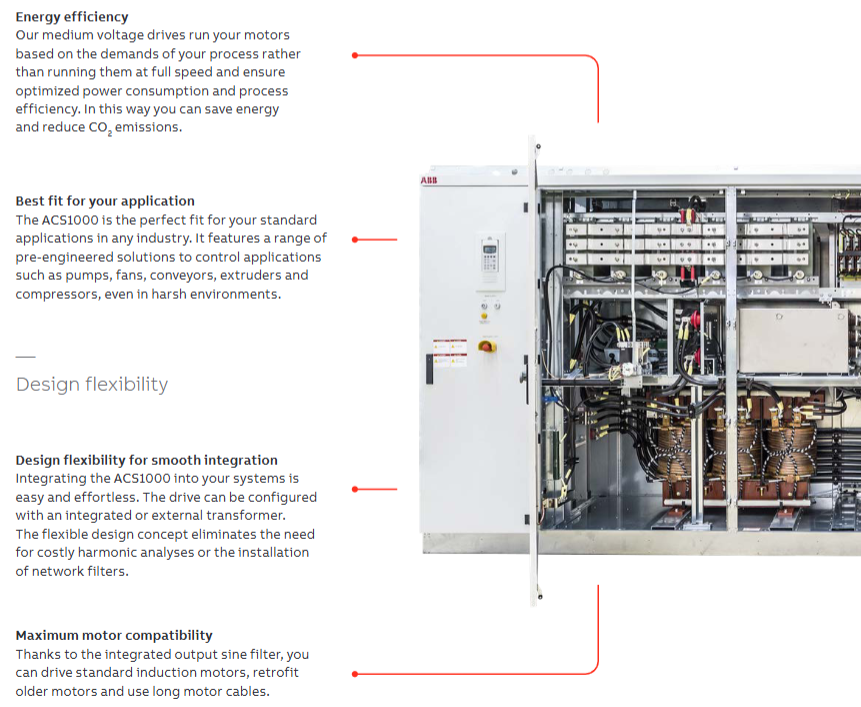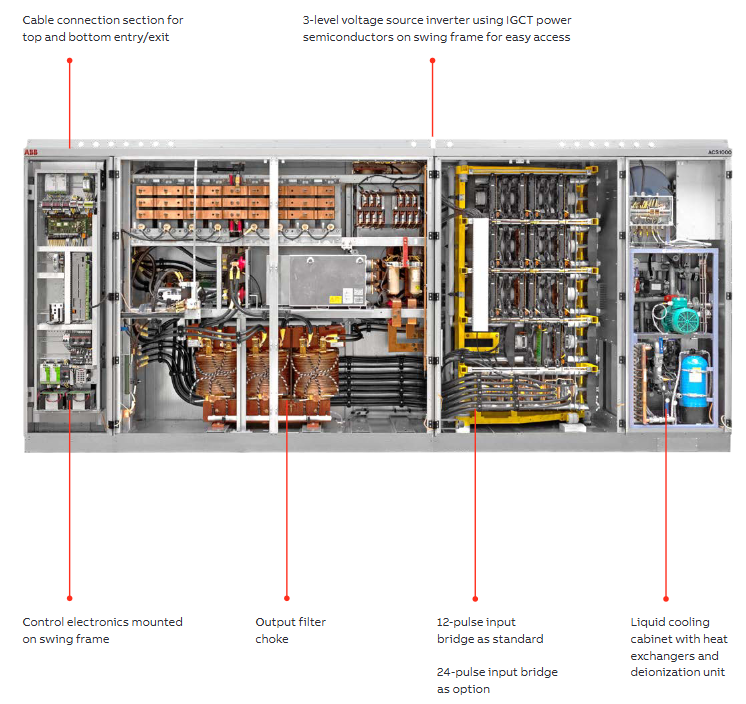

K-WANG


ABB ACS1000 series medium voltage frequency converter
Efficient and reliable: Adopting direct torque control (DTC) technology, the dynamic response is fast (speed step response ≤ 10 ms), the speed regulation accuracy is high (± 0.1% rated speed), and the power factor is ≥ 0.95 (at full load), reducing power grid losses.
Flexible adaptation: Supports multiple motor types (asynchronous motor, synchronous motor), can be configured as a single drive or multi drive system, and adapts to the load characteristics of different industrial scenarios (such as constant torque, variable torque).
High availability: Modular design supports online maintenance, key components such as power modules and cooling systems can be redundantly configured, with a long mean time between failures (MTBF), reducing the risk of downtime.
Environmental Protection and Compliance: The input current harmonic distortion (THD) is low (≤ 5%), and it can meet international standards without the need
ABB ACS1000 series medium voltage frequency converter
Product positioning and core advantages
ACS1000 is a medium voltage AC drive solution launched by ABB, designed specifically for controlling medium and high voltage motors. It covers a power range of 1.1-63 MW and is compatible with voltage levels of 2.3-11 kV. Its core advantages include:
Efficient and reliable: Adopting direct torque control (DTC) technology, the dynamic response is fast (speed step response ≤ 10 ms), the speed regulation accuracy is high (± 0.1% rated speed), and the power factor is ≥ 0.95 (at full load), reducing power grid losses.
Flexible adaptation: Supports multiple motor types (asynchronous motor, synchronous motor), can be configured as a single drive or multi drive system, and adapts to the load characteristics of different industrial scenarios (such as constant torque, variable torque).
High availability: Modular design supports online maintenance, key components such as power modules and cooling systems can be redundantly configured, with a long mean time between failures (MTBF), reducing the risk of downtime.
Environmental Protection and Compliance: The input current harmonic distortion (THD) is low (≤ 5%), and it can meet international standards without the need

Technical architecture and core components
1. Topological structure
Adopting a three-level NPC (neutral point clamp) inverter design, precise control of voltage and frequency is achieved through IGBT power devices. Compared to traditional two-level topologies, the output harmonics are lower and the motor insulation is friendly.
2. Core components
Power module: including rectifier, inverter, and buffer circuit, divided into different frame sizes according to power level (such as Frame 1-6), supporting parallel expansion.
Control unit: Based on ABB DTC technology, integrated PLC function, supports logic control, sequence control, and PID regulation, and can be operated through Panel Control panel or upper system.
Cooling system: Provides two solutions: air cooling (AC) and water cooling (WC). Water cooling is suitable for high power density scenarios (such as 10 MW or more) and supports connection to heat exchangers or cooling towers.
Auxiliary equipment: optional EMC filters, input isolation transformers, braking units, sine wave filters (to reduce motor harmonic losses), etc.

Model specifications and performance parameters
1. Power and voltage range
Voltage level (kV) Power range (MW) Suitable motor current (A) Typical application scenarios
2.3 1.1-18 300-4500 fans and pumps
3.3 1.5-25 250-4800 Compressor and Conveyor Belt
4.16 2.0-30 300-4200 rolling mill and crusher
6.6 3.0-40 250-3500 Mine Hoist
11 5.0-63 250-3200 Large pump stations, power plant auxiliary equipment
2. Key Performance
Speed range: 1:1000 (closed-loop control), 1:100 (open-loop control).
Overload capacity: 110% rated load for 60 seconds, 150% rated load for 2 seconds (applicable for starting impact loads).
Efficiency: ≥ 97% under rated load (including isolation transformer).
Protection level: Power unit IP21/IP23 (air cooling), IP54 (water cooling), control cabinet IP42/IP54.

Application scenarios and typical configurations
1. Main industry applications
Electricity: boiler fan, feedwater pump, condensate pump, desulfurization system.
Metallurgy: main drive of rolling mill, coiler, blast furnace fan.
Oil and gas: oil pumps, compressors, and natural gas pipeline pressurization.
Water treatment: large sewage pumps, water supply booster pumps.
Mining: Mine hoist, crusher, scraper conveyor.
2. Typical configuration examples
Standard configuration for fans/pumps: ACS1000 host+air cooling+input isolation transformer+MODBUS communication.
High precision transmission configuration: ACS1000 host+water cooling+encoder feedback+PROFIBUS-DP+sine wave filter.
Service and Support
Full lifecycle services: including installation and commissioning, training, preventive maintenance, remote monitoring (through ABB Ability) ™ Platform, spare parts supply, etc.
Customized solution: Cabinet layout, interface protocols (such as PROFINET, EtherNet/IP), redundant configuration, etc. can be designed according to customer needs.

- YOKOGAWA
- Energy Access
- Renewable Integration
- Energy Subsidies
- Energy and Water
- Net zero emission
- Energy Security
- Critical Minerals
- A-B
- petroleum
- Mine scale
- Energy and Gender
- Covid-19
- man-machine
- Reliance
- ADVANCED
- SEW
- ProSoft
- WATLOW
- Kongsberg
- FANUC
- VSD
- DCS
- PLC
- Sewage treatment
- cement
- Yaskawa
- Woodward
- BOSCH Rexroth
- MOOG
- General Electric
- American NI
- Rolls-Royce
- CTI
- Honeywell
- EMERSON
- xYCOM
- Construction site
- Siemens
- architecture
- Industrial information
- New energy
- Automobile market
- electricity
- Motorola
- HIMA
- ABB
- Rockwell
- Schneider Modicon
- MAN
- GE
- TRICONEX
- Control Wave
- ALSTOM
- AMAT
- STUDER
- KONGSBERG
- MOTOROLA
- DANAHER MOTION
- Bentley
- Galil
- EATON
- MOLEX
- Triconex
- DEIF
- B&W
- ZYGO
- Aerotech
- DANFOSS
- KOLLMORGEN
- Beijer
- Endress+Hauser
- schneider
- Foxboro
- KB
- REXROTH
-
Kollmorgen S33GNNA-RNNM-00 - Brushless Servo Motor
-
Kollmorgen 6sm56-s3000-g-s3-1325 - Servo Motor
-
Kollmorgen AKM52K-CCCN2-00 - Servo Motor
-
Kollmorgen PSR3-230/75-21-202 - Power Supply
-
Kollmorgen akm24d-anc2r-00 - Servo Motor
-
Kollmorgen AKM22E-ANCNR-00 - Servo Motor
-
Kollmorgen S60300-550 - Servo Drive
-
Kollmorgen B-204-B-21 - Servomotor
-
Kollmorgen AKM21E-BNBN1-00 - Servo Motor
-
Kollmorgen TT2953-1010-B - DC Servo Motor
-
Kollmorgen pa8500 - Servo Power Supply
-
Kollmorgen BDS4A-210J-0001-207C2 - Servo Drive
-
Kollmorgen TTRB1-4234-3064-AA - DC Servo Motor
-
Kollmorgen MH-827-A-43 - Servo Motor
-
Kollmorgen AKM24D-ACBNR-OO - Servo Motor
-
Kollmorgen 00-01207-002 - Servo Disk DC Motor
-
Kollmorgen AKM21C-ANBNAB-00 - Servo Motor
-
Kollmorgen PSR3-208/50-01-003 - Power Supply
-
Kollmorgen 6SM56-S3000 - Servo Motor
-
Kollmorgen DBL3H00130-B3M-000-S40 - Servo Motor
-
Kollmorgen 6SN37L-4000 - Servo Motor
-
Kollmorgen AKM65K-ACCNR-00 - Servo motor
-
Kollmorgen 6SM56-L3000-G - Servo Motor
-
Kollmorgen AKMH43H-CCCNRE5K - Servo Motor
-
Kollmorgen PSR4/52858300 - Power Supply
-
Kollmorgen KBM-79H03-E03 - Direct Drive Rotary Motor
-
Kollmorgen AKM33E-ANCNDA00 - Servo Motor
-
Kollmorgen U9M4/9FA4T/M23 - ServoDisc DC Motor
-
Kollmorgen AKM13C-ANCNR-00 - Servo Motor
-
Kollmorgen AKM43L-ACD2CA00 - Servo Motor
-
Kollmorgen AKM54K-CCCN2-00 - Servo Motor
-
Kollmorgen M-605-B-B1-B3 - Servo Motor
-
Kollmorgen AKD-P00606-NBAN-0000 - Rotary Drive
-
Kollmorgen 6SM-37M-6.000 - Servo Motor
-
Kollmorgen A.F.031.5 - Sercos Interface Board
-
Kollmorgen 918974 5054 - Servo PWM
-
Kollmorgen U12M4 - ServoDisc DC Motor
-
Kollmorgen AKD-B00606-NBAN-0000 - Servo Drive
-
Kollmorgen MV65WKS-CE310/22PB - Servo Drive
-
Kollmorgen 65WKS-CE310/22PB - Servo Drive
-
Kollmorgen EM10-27 - Module
-
Kollmorgen S64001 - Servo Drive
-
Kollmorgen CR03200-000000 - Servo Drive
-
Kollmorgen 6SM57M-3000+G - Servo Motor
-
Kollmorgen BDS4 - Servo Drive
-
Kollmorgen AKD-P00306-NBEC-000 - Servo Drive
-
Kollmorgen AKD-B01206-NBAN-0000 - Servo Drive
-
Kollmorgen STP-57D301 - Stepper Motor
-
Kollmorgen 6SM37L-4.000 - Servo Motor
-
Kollmorgen 44-10193-001 - Circuit Board
-
Kollmorgen PRDR9SP24SHA-12 - Board
-
Kollmorgen PRD-AMPE25EA-00 - Servo Drive
-
Kollmorgen DBL3N00130-0R2-000-S40 - Servo Motor
-
Kollmorgen S406BA-SE - Servo Drive
-
Kollmorgen AKD-P00607-NBEI-0000 - Servo Drive
-
Kollmorgen AKD-P01207-NBEC-0000 - Servo Drive
-
Kollmorgen CR03550 - Servo Drive
-
Kollmorgen VSA24-0012/1804J-20-042E - Servo Drive
-
Kollmorgen N2-AKM23D-B2C-10L-5B-4-MF1-FT1E-C0 - Actuator
-
Kollmorgen 04S-M60/12-PB - Servo Drive
-
Kollmorgen H33NLHP-LNW-NS50 - Stepper Motor
-
Kollmorgen A-78771 - Interlock Board
-
Kollmorgen AKM43E-SSSSS-06 - Servo Motor
-
Kollmorgen AKD-P00607-NBEC-0000 - Servo Drive
-
Kollmorgen E21NCHT-LNN-NS-00 - Stepper Motor
-
Kollmorgen cr10704 - Servo Drive
-
Kollmorgen d101a-93-1215-001 - Motor
-
Kollmorgen BDS4A-203J-0001-EB202B21P - Servo Drive
-
Kollmorgen MCSS23-6432-002 - Connector
-
Kollmorgen AKD-P01207-NACC-D065 - Servo Drive
-
Kollmorgen CK-S200-IP-AC-TB - I/O Adapter and Connector
-
Kollmorgen CR10260 - Servo Drive
-
Kollmorgen EC3-AKM42G-C2R-70-04A-200-MP2-FC2-C0 - Actuator
-
Kollmorgen BDS5A-206-01010-205B2-030 - Servo Drive
-
Kollmorgen s2350-vts - Servo Drive
-
Kollmorgen AKM24D-ANC2DB-00 - Servo Motor
-
Kollmorgen E31NCHT-LNN-NS-01 - Stepper Motor
-
Kollmorgen PRD-0051AMPF-Y0 - Servo Board
-
Kollmorgen TB03500 - Module
-
Kollmorgen 60WKS-M240/06-PB - Servo Drive
-
Kollmorgen M21NRXC-LNN-NS-00 - Stepper Motor
-
Kollmorgen H-344H-0212 - Servo Motor
-
Kollmorgen MCSS08-3232-001 - Connector
-
Kollmorgen AKM33H-ANCNC-00 - Servo Motor
-
Kollmorgen PA-2800 - Power Supply
-
Kollmorgen MTC308C1-R1C1 - Servo Motor
-
Kollmorgen PRDR0091300Z-00 - Capacitor Board
-
Kollmorgen BDS4A-206J-0024/01502D79 - Servo Drive
-
Kollmorgen S20330-VTS - Servo Drive
-
Kollmorgen S20250-CNS - Servo Drive
-
Kollmorgen SBD2-20-1105-WO - Servo Drive Board
-
Kollmorgen M405-C-A1--E1 - Servo Motor
-
Kollmorgen PRD-PB805EDD-00 - Servo Drive
-
Kollmorgen 6SM57S-3.000-J-09-HA-IN - Servo Motor
-
Kollmorgen AKM33H-ANCNDA-00 - Servo Motor
-
Kollmorgen PCB-00030200-04 - PCB
-
Kollmorgen H22SSLB-LNN-NS-02 - Stepper Motor
-
Kollmorgen BJRL-20012-110001 - Module
-
Kollmorgen BDS4A-206J-0001404A - Servo Drive
-
Kollmorgen H-342-H-0802 - Servo Motor
-
Kollmorgen CR10561 - Servo Drive
-
Kollmorgen BDS5A-206-00010-205B2-030 - Servo Drive
-
Kollmorgen BDS5A-206-00010-207B-2-030 - Servo Drive
-
Kollmorgen mcss08-3224-001 - Connector
-
Kollmorgen M-207-B-23-B3 - Servo Motor
-
Kollmorgen PRD-0041200Z-S0 - Encoder/Resolver Card
-
Kollmorgen MH-225-G-61 - Motor
-
Kollmorgen MT308B1-T1C1 - Servo Motor
-
Kollmorgen BDS4A-240J-0001604C83 - Servo Drive
-
Kollmorgen 6SM57-S-3000 - Servo Motor
-
Kollmorgen N-T31V-15-5B-6-MF3-FT1E-C251 - Actuator
-
Kollmorgen PRD-0051AMPA-X0 - Servo Board
-
Kollmorgen CF-SS-RHGE-09 - Cable
-
Kollmorgen DIGIFAS7204 - Servo Drive
-
Kollmorgen S30101-NA - Servo Drive
-
Kollmorgen DIGIFAS7201 - Servo Drive
-
Kollmorgen PRD-0051AMPA-Y0 - Servo Board
-
Kollmorgen AKM23D-EFCNC-00 - Servo Motor
-
Kollmorgen SE10000 - Servo Drive
-
Kollmorgen PSR4/5A-112-0400 - Power Supply
-
Kollmorgen AKM31H-ANCNC-01 - Servo Motor
-
Kollmorgen M-203-B-93-027 - Servo Motor
-
Kollmorgen CP-SS-G1HE-05 - Connector
-
Kollmorgen AKM42G-ASCNR-02 - Servo Motor
-
Kollmorgen DBL4N00750-B3M-000-S40 - Servo Motor
-
Kollmorgen R3-BK23-152B-12-PL-ASE-BS115 - Actuator
-
Kollmorgen MH-427-B-61 - Motor
-
Kollmorgen cr06902 - Servo Drive




